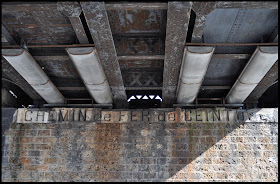
Last April we took a walk through the eastern fringe of Paris, following, so far as possible, the line of La Petite Ceinture, the city’s long abandoned circular railway route. Previous postings on this topic are here and here. The continued existence of this anachronism is a source of fascination to many and the subject of an exhaustive monograph, La Saga de la Petite Ceinture by Bruno Carrière. The need for this orbital railway rapidly declined after the opening of the Métro and regular service on la Petite Ceinture ceased in 1934. It is ironic that after more than 75 years the migration of workplaces from the centre to the suburbs and the development of high-density housing along the outer boulevards have created a demand for the very links that the Petite Ceinture was intended to deliver. Contractors are hard at work tearing up the roadway to accommodate the planned extension of tram route T3 from Porte d’Ivry to Porte de la Chapelle following a route that closely shadows the line of the Petite Ceinture and is due to open in 2012.

Our northward exploration of the Est-Ceinture began at Bel-Air and concluded at the entrance to the tunnel that runs under the streets of Ménilmontant, having crossed east-west axes at avenue de St-Mandé, Cours de Vincennes, rue d’Avron and rue de Bagnolet. The streets we walked were uncannily deserted as if the energy of the city were dissipated at the margins. Strong sunlight produced intense contrasts of light and shade, enhancing the sense of dislocation. The track infrastructure is heavily defended with high security fencing to discourage the urban explorers. It must be conceded that the itinerary lacked much in the way of spectacle so the excitement at encountering one of only two level crossings in Paris (in rue de Lagny) has to be seen in context. The real reward was visiting just those nondescript locations that railways so often run through – places whose identity and distinctiveness have been silently extinguished by neglect but have the compensatory merit of having mostly escaped the attention of developers (often because of the presence of the railway).




The vintage postcard below shows an extérieure train departing southbound from the station Avenue de Vincennes as photographed from one of the logements on the south side of Cours de Vincennes. The gas holders on the left have been replaced by the Charonne métro workshops and the Collège Maurice Ravel while a 10 storey housing development occupies the area on the right. The image is pre-1914 and shows an industrialised zone of which no trace remains other than the silent rusting tracks of the Petite Ceinture.


I have long been fascinated by the Petite Ceinture. At a bouquiniste's stall, I found a map dating from 1897 that shows the whole line with all its stations (I have posted the map at http://parisianfields.wordpress.com). The map shows the connections with the main line stations, as well as stations that have since disappeared. I have photographed the line from some of the bridges, but never dared walk along it. Maybe one day!
ReplyDeleteI am no great expert in the dark arts of trespass but there is easy access to the pc in Buttes-Chaumont. When I was there in April there were already 3 others on the scene when I arrived. I am a figure of fun in my family for my reluctance to be involved in anything with the slightest hint of illegality about it so it was a major step for me!
ReplyDelete